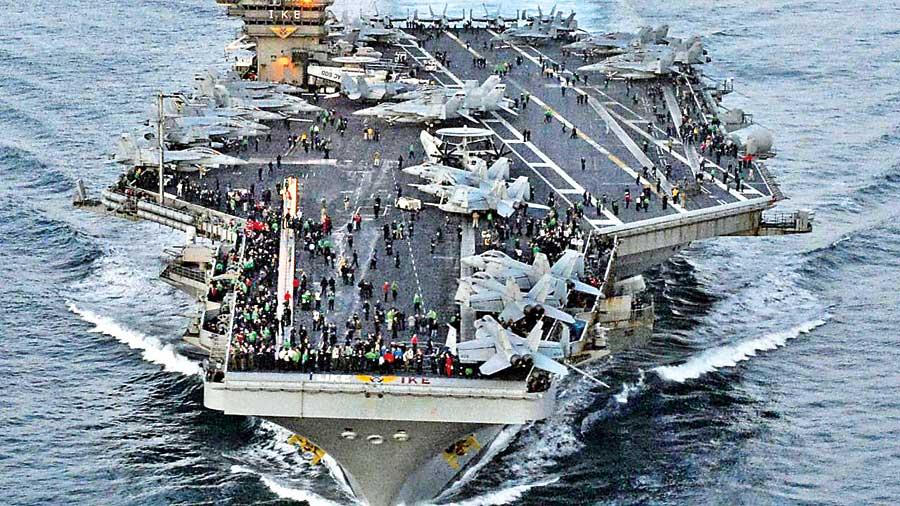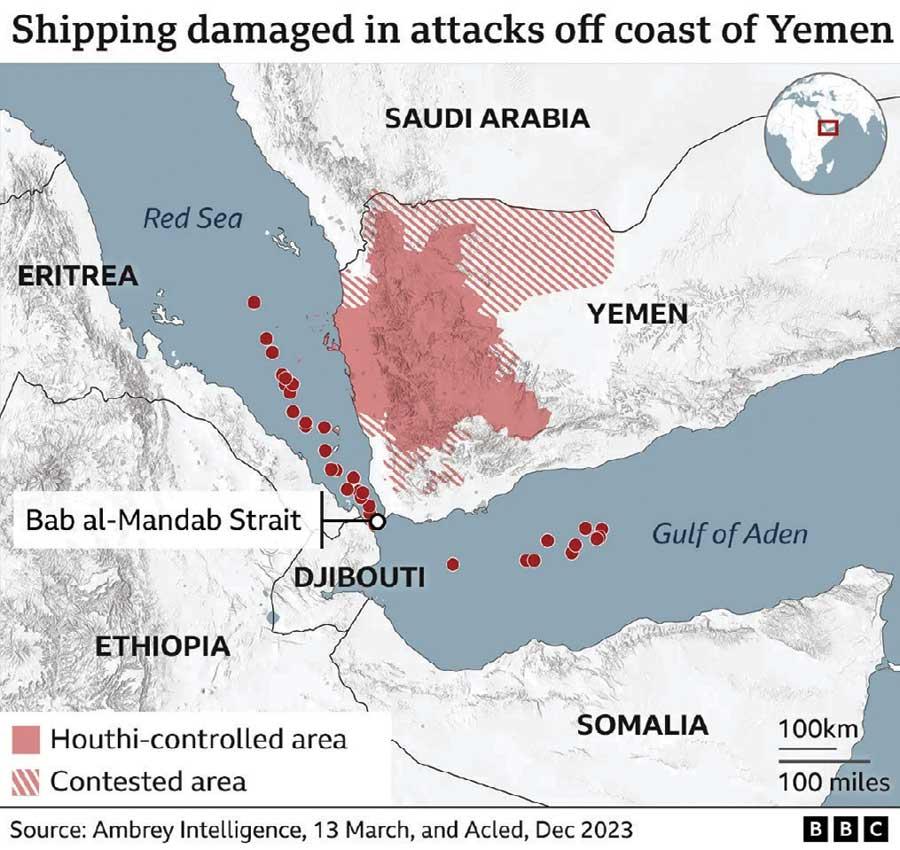08 Jul 2024 - {{hitsCtrl.values.hits}}

The Houthi missile attack on the US Navy aircraft carrier Dwight D. Eisenhower is a game changing event in the annals of naval warfare
The Houthis (Iran-backed Ansar-Allah movement) fighting the government of Yemen control large coastal areas bordering the Red Sea
The Houthi missile attack on the US Navy aircraft carrier Dwight D. Eisenhower is already history, as far as the public is concerned. But it isn’t forgotten by either the attacker or the target,
 because it’s a game-changing event in the annals of naval warfare, a mouse attacking an elephant and forcing it to retreat.
because it’s a game-changing event in the annals of naval warfare, a mouse attacking an elephant and forcing it to retreat.
The US Navy acknowledged the attack and rejected claims by the Yemen-based Houthis that the Eisenhower and its escort, the guided missile destroyer USS Bradley were both damaged in the drone attack.
The video circulating in social media of the nuclear-powered carrier sailing at night with fires on the deck could be faked. Even if a missile from a drone hit the carrier’s armoured hull and deck, the damage caused would be minimal, and it is equipped with missile defense systems and a 20mm anti-aircraft cannon.
But the fact remains that the USS Eisenhower took refuge in the Saudi Arabian port of Jeddah after the attack. It is the only friendly port in the region where an American warship could dock in an emergency. The question remains—was that a previously scheduled docking, or the carrier’s commander, feeling rattled by the Houthi attack decide to find shelter?
Neutral ports
On a much-reduced scale, this is reminiscent of the Russian Baltic fleet, or what remained of it, taking refuge in neutral ports after a disastrous battle with the Japanese navy in the Tsushima Straits in 1905. The losses were so great that Russia did not start rebuilding a blue-water navy till the 1970s.
The Houthis do not have a navy. All their attacks on Red Sea shipping originate from land bases. But impartial analysts acknowledge that their techniques and ability to disrupt one of the most vital shipping routes in the world with very inexpensive but sophisticated technology is both unprecedented and revolutionary, since the Houthis began their attacks on Red Sea shipping on 19 October 2023, soon after Hamas attacked Israel.
The Houthis (Iran-backed Ansar-Allah movement) fighting the government of Yemen control large coastal areas bordering the Red Sea. They said attacks on Red Sea shipping were in retaliation to the Israeli bombardment of the Gaza Strip, and related Western support for Israel. Apart from launching missile and drone attacks on Israeli targets, the Houthis have regularly attacked merchant vessels in the Red Sea, damaging at least 25 so far. They have also seized several.
Military targets
They have been less successful against military targets, only managing to damage a British landing craft. But, their success has to be measured in other terms – ten countries are now pitted in this battle against the Houthis, and the US Navy, geared since the Cold War to fight superpowers, is now pitted in a seemingly no-win battle against a land-based guerrilla group with no navy. It has been forced to send the nuclear-powered Eisenhower, the world’s third-largest aircraft carrier ith 90 aircraft, to the region.
Its F/A18 Hornets and missiles from other US ships have destroyed many Houthi drones and ant-ship cruise missiles, but the attacks continue. If the Eisenhower was docked in Jeddah because it feared more Houthi attacks, that would be a new chapter in the history of warfare, with relatively small armed groups (not even nations) able to threaten much larger, much-better equipped forces and force them into defensive action (Houthi strength is not precisely known, and estimates vary between 50,000 and 100,000).
The Soviet-era weaponry
Houthis are backed by Iran, which has no strong navy, either. But Iran is adept at modifying Soviet-era weaponry to modern warfare. The old Soviet P-21 anti-ship cruise missile modified by them and given to the Houthis has been very effective against Red Sea shipping, so much so that the overall volume of shipping has dropped over the past months.
It was reported by Russian state media that the Houthis now possess a hypersonic missile supplied by Iran. If true, this would up the stakes a great deal. Unlike a cruise missile which flies on a regular trajectory and can be intercepted by for eg. an American Patriot missile, a hypersonic missile can change its trajectory and is hence harder to intercept.
Those missiles hitherto used by the Houthis have a range of up to 80km. The Eisenhower was beyond that range when attacked, hence the use of drones. But these can’t sink an armoured ship. The US Navy hasn’t disclosed the width of this carrier’s steel deck, but it would be certainly more than a foot thick.
An aircraft carrier has been symbolic of a navy’s strength since World War II. Japan lost the war when it lost its principal carrier fleet in the Battle of Midway. The US has led the world in carrier strength since then. It has more carriers than Britain, France, Russia and India combined. China is new to this game but is catching up fast, building five new aircraft carriers.
But the lesson of just how vulnerable an aircraft carrier has been displayed vividly by a rebel group in Yemen.

24 Nov 2024 3 hours ago
24 Nov 2024 5 hours ago
24 Nov 2024 6 hours ago
24 Nov 2024 7 hours ago